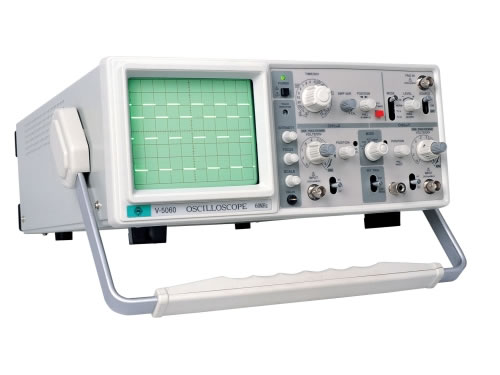40MHz Analog Oscilloscope
Description
Analog oscilloscope, which employs cathoderay tubes to display a waveform, is the first oscilloscope that is used by engineers. It uses electronic gun to emit electrons to the screen. The emitted electrons form into electron beam by focusing. Then the electron beam is irradiated to the screen coated with fluorescent material and gives out light. It shows the signal waveform by inputting signal to control the deflection of electron beam. 40 MHz analog oscilloscope is widely used in science, pharmacy, engineering and telecommunication industries.
Advantages
1. 40 MHz analog oscilloscope is simple to operate. All the operation processes are finished in the faceplate so that the waveform responses in a quick manner.
2. Analog storage oscilloscope has high vertical resolution which is also continuous and unlimited.
3. It is fast in data update because it captures hundreds and thousands of waveforms every minute.
4. 40 MHz analog oscilloscope provides visible waveforms to the technicians who can take tests easily within the regulated bandwidth.
Parameters
| CRT | ||
| Screen | 6" screen with internal graticule: 8×10 divisions (1 division=1cm) | |
| Accelerating Voltage | +12kv | |
| Phosphor | P31 standard | |
| Focusing | Adjustable | |
| Trace Rotation | Adjustable | |
| Intensity Control | Provided | |
| Vertical Deflection | ||
| Bandwidth | DC Coupling | DC to 40MHz (Normal) DC to 7MHz (Magnified) |
| AD Coupling | 10Hz to 40MHz (Normal) 10Hz to 7MHz (Magnified) | |
| Deflection Factor | 5mV/div to 5V/div in 10 steps of 1-2-5 sequence (X5 Magnified: 1mV/div to 1V/div in 10 steps) | |
| Display Mode | CH1, CH2, ADD, ALT, CHOP | |
| Accuracy | Normal: ±3%, Magnified: ±5% | |
| Input Impedance | 1MΩ, 25pF | |
| Max. Input Voltage | 250V (DC+AC peak) | |
| CH1 Output | 20mV/div (in 50Ω, 20Hz to 10MHz) | |
| Rise Time | ≤8.8ns | |
| Polarity Inversion | CH2 Only | |
| Horizontal Deflection | ||
| Time Base | 0.2μs/div to 0.2s/div in 9 steps of 1-2-5 sequence. | |
| Sweep Magnification | X10 | |
| CH1 ALT Magnification | X10 | |
| Accuracy | Normal: ±3%, Magnified: ±5% | |
| X-Y Mode | ||
| X-Axis | CH1 (Bandwidth: DC-500kHz) | |
| Y-Axis | CH2 | |
| X-Y Phase Difference | 3° or less (DC-50kHz) | |
| Trigger System | ||
| Mode | NORM, AUTO, TV-V, TV-H | |
| Trigger source | CH1,CH2,VERT, LINE, EXT | |
| Coupling | AC | |
| Slope | + or - | |
| Sensitivity & Frequency | 0.5 div (0.5Vp-p EXT), 10Hz-40MHz 1.0 div or 1Vp-p, TV | |
| Calibrator | ||
| Frequency | 1kHz ±20% | |
| Voltage | 0.5V ±10% | |
| Power Supply | ||
| Voltage Range | 220V/110V ±10% | |
| Fuse | 0.5A/1A | |
| Frequency | 50Hz-60Hz | |
| Physical | ||
| Dimensions | 310(W) × 130(H) × 370(D) mm | |
| Weight | 9kg | |
Notes
In order to avoid electrical shock, the protective grounding conductor of power cord should be connected to ground.
Maintenance
1. Keep regular cleaning so as to maintain good ventilation of analog oscilloscope.
2. Do not spray cleaner directly onto the instrument when cleaning it. Please use a soft cloth with mild detergent and water instead.

- 60 MHz Analog OscilloscopeOscilloscopes are used to observe the change of an electrical signal over time. The constantly varying signal voltage can be graphed on the screen, which is commonly referred to as a waveform.1. 60 MHz analog oscilloscope is widely used in science, pharmacy, engineering and telecommunication industries. 2. It can be used to observe waveforms of different signal amplitudes over...




